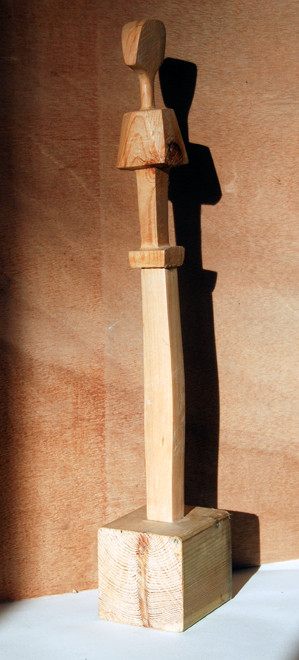Other Wood Pieces






These were the first carved wooden sculptures I made after my move from Cornwall to London. I was living in Catford and working in the back room of the house. I had made a workbench from wood salvaged from the Thames near the Dome (See Studio Shots) and I had bought a set of gouges from a shop in New York called the Compleat Sculptor. I then got some wood and got going.
I know, from going to Art School, that this is not the prescribed way of doing things. But I just needed to make a start. So these pieces are more experiments in wood than anything else. However, I don't much believe in the idea of 'finding' the sculpture in the wood. Rather, it is about a dialogue with the particular piece of wood - its shape, weight, smell, colour, grain, texture, condition, and internal structure - and the thoughts and references and emotions and ideas in the artist's head. And the tools, techniques, training, technical assistance and workspace at their disposal. And this dialogue develops and changes through the process of working on the piece of wood.
David Easterly, who is a carver, says in Grinling Gibbons and the Art of Carving (V&A, 1998):
A carver begins as a god and ends as a slave. With vicious tools he starts by imposing his will on a passive and undefiled board. As the carving progresses, however, the balance of power shifts. Forms emerge and gather their own potency. Soon the carving begins to make suggestions to the carver; then it makes demands; finally it becomes a pitiless taskmaster, commanding now this, now that detail. The carving is finished when the carver finally loses patience with such thraldom, and removes the carving from the workbench.’ (204)
And
As carving takes shape it acquires a power and beauty of its own. It usurps its makers will with its own will. Eventually, the carver, whose options are dwindling anyway, can do no better than obey the voice that speaks from the half shaped forms before him.’ (204)
Much of this early work seemed to be about limitations - of my skill, tools, the space I was working in, my neighbour's amazing tolerance (Thank you, Roy and Eileen) and my stuttering sense of confidence and engagement. It's not like the pieces didn't have ideas behind them but rather that the ideas, such as they were, emerged out of the process of making the piece. Sometimes you just have to start.
